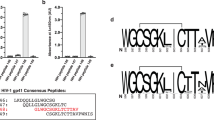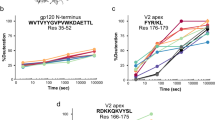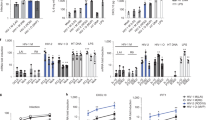Abstract
Rhesus macaque TRIMCyp (RhTC) is a potent primate antiviral host protein that inhibits the replication of diverse HIV viruses. Here we show that it has acquired the ability to target multiple viruses by evolving an active site that interconverts between multiple conformations. Mutations that have relieved active site constraints allow RhTC to dynamically sample conformational space, including radically different conformers that target both HIV-1 and HIV-2 viruses. Introduction of a reversible constraint into RhTC allows specificity to be switched between a single conformation specific for HIV-1 and a dynamic ensemble that targets multiple viruses. These results show that conformational diversity can be used to expand the target diversity of innate immune receptors by supplementing their limited genetic variability with variability in protein structure.
This is a preview of subscription content, access via your institution
Access options
Subscribe to this journal
Receive 12 print issues and online access
$189.00 per year
only $15.75 per issue
Buy this article
- Purchase on Springer Link
- Instant access to full article PDF
Prices may be subject to local taxes which are calculated during checkout





Similar content being viewed by others
References
Stremlau, M. et al. The cytoplasmic body component TRIM5α restricts HIV-1 infection in old world monkeys. Nature 427, 848–853 (2004).
Sayah, D.M. et al. Cyclophilin A retrotransposition into TRIM5 explains owl monkey resistance to HIV-1. Nature 430, 569–573 (2004).
Wilson, S.J. et al. Independent evolution of an antiviral TRIMCyp in rhesus macaques. Proc. Natl. Acad. Sci. USA 105, 3557–3562 (2008).
Price, A.J. et al. Active site remodeling switches HIV specificity of antiretroviral TRIMCyp. Nat. Struct. Mol. Biol. 16, 1036–1042 (2009).
Virgen, C.A. et al. Independent genesis of chimeric TRIM5-cyclophilin proteins in two primate species. Proc. Natl. Acad. Sci. USA 105, 3563–3568 (2008).
Gamble, T.R. et al. Crystal structure of human cyclophilin A bound to the amino-terminal domain of HIV-1 capsid. Cell 87, 1285–1294 (1996).
Vajdos, F.F. et al. Crystal structure of cyclophilin A complexed with a binding site peptide from the HIV-1 capsid protein. Protein Sci. 6, 2297–2307 (1997).
Yoo, S. et al. Molecular recognition in the HIV-1 capsid/cyclophilin A complex. J. Mol. Biol. 269, 780–795 (1997).
Howard, B.R. et al. Structural insights into the catalytic mechanism of cyclophilin A. Nat. Struct. Biol. 10, 475–481 (2003).
Ke, H. Similarities and differences between human cyclophilin A and other beta-barrel structures. Structural refinement at 1.63 Å resolution. J. Mol. Biol. 228, 539–550 (1992).
Ottiger, M. et al. The NMR solution conformation of unligated human cyclophilin A. J. Mol. Biol. 272, 64–81 (1997).
Eisenmesser, E.Z. et al. Intrinsic dynamics of an enzyme underlies catalysis. Nature 438, 117–121 (2005).
Peng, J.W. & Wagner, G. Investigation of protein motions via relaxation measurements. Methods Enzymol. 239, 563–596 (1994).
Henzler-Wildman, K.A. et al. A hierarchy of timescales in protein dynamics is linked to enzyme catalysis. Nature 450, 913–916 (2007).
Gao, F. et al. Origin of HIV-1 in the chimpanzee Pan troglodytes troglodytes. Nature 397, 436–441 (1999).
Keckesova, Z., Ylinen, L.M. & Towers, G.J. The human and African green monkey TRIM5α genes encode Ref1 and Lv1 retroviral restriction factor activities. Proc. Natl. Acad. Sci. USA 101, 10780–10785 (2004).
Yap, M.W. et al. Trim5α protein restricts both HIV-1 and murine leukemia virus. Proc. Natl. Acad. Sci. USA 101, 10786–10791 (2004).
Hatziioannou, T. et al. Retrovirus resistance factors Ref1 and Lv1 are species-specific variants of TRIM5α. Proc. Natl. Acad. Sci. USA 101, 10774–10779 (2004).
Diehl, W.E. et al. Identification of post-entry restrictions to Mason-Pfizer monkey virus infection in New World monkey cells. J. Virol. 82, 11140–11151 (2008).
Yap, M.W. et al. Restriction of foamy viruses by primate TRIM5α. J. Virol. 82, 5429–5439 (2008).
Ganser-Pornillos, B.K. et al. Hexagonal assembly of a restricting TRIM5α protein. Proc. Natl. Acad. Sci. USA 108, 534–539 (2011).
Brown, E.W. et al. A lion lentivirus related to feline immunodeficiency virus: epidemiologic and phylogenetic aspects. J. Virol. 68, 5953–5968 (1994).
Leslie, A.G. Recent changes to the MOSFLM package for processing film and image plate data. in Joint CCP4 and ESF-EACBM Newsletter on Protein Crystallography Number 26 (Daresbury Laboratory, 1992).
Collaborative Computational Project N. The CCP4 suite: programs for protein crystallography. Acta Crystallogr. D Biol. Crystallogr. 50, 760–763 (1994).
McCoy, A.J. et al. Phaser crystallographic software. J. Appl. Crystallogr. 40, 658–674 (2007).
Emsley, P. et al. Features and development of Coot. Acta Crystallogr. D Biol. Crystallogr. 66, 486–501 (2010).
Murshudov, G.N., Vagin, A.A. & Dodson, E.J. Refinement of macromolecular structures by the maximum-likelihood method. Acta Crystallogr. D Biol. Crystallogr. 53, 240–255 (1997).
Chen, V.B. et al. MolProbity: all-atom structure validation for macromolecular crystallography. Acta Crystallogr. D Biol. Crystallogr. 66, 12–21 (2010).
Bieri, M. & Gooley, P.R. Automated NMR relaxation dispersion data analysis using NESSY. BMC Bioinformatics 12, 421 (2011).
Acknowledgements
We thank the staff at Beamline ID23-1 of the ESRF (Grenoble, France) and Beamline I03 of the Diamond Light Source (Didcot, UK) for expert assistance and D. Neuhaus and P. Evans for helpful discussions. O. Perisic (MRC Laboratory of Molecular Biology) for plasmids. This work was funded by the Medical Research Council (UK) and the European Research Council (281627-IAI).
Author information
Authors and Affiliations
Contributions
M.E.C.C. and A.J.P. determined crystal structures and carried out ITC experiments; K.B. did NMR dynamics studies; S.M.V.F. did NMR dynamics studies and co-wrote the manuscript; W.A.M. carried out ITC experiments; G.J.T. and B.J.W. supplied materials and assisted with writing; L.C.J. designed experiments and wrote the manuscript.
Corresponding authors
Ethics declarations
Competing interests
The authors declare no competing financial interests.
Supplementary information
Supplementary Text and Figures
Supplementary Figures 1–4, Supplementary Table 1 and Supplementary Methods (PDF 2178 kb)
Rights and permissions
About this article
Cite this article
Caines, M., Bichel, K., Price, A. et al. Diverse HIV viruses are targeted by a conformationally dynamic antiviral. Nat Struct Mol Biol 19, 411–416 (2012). https://doi.org/10.1038/nsmb.2253
Received:
Accepted:
Published:
Issue Date:
DOI: https://doi.org/10.1038/nsmb.2253
This article is cited by
-
TRIM5α self-assembly and compartmentalization of the HIV-1 viral capsid
Nature Communications (2020)
-
Temperature-jump solution X-ray scattering reveals distinct motions in a dynamic enzyme
Nature Chemistry (2019)
-
Restriction of HIV-1 and other retroviruses by TRIM5
Nature Reviews Microbiology (2019)
-
The innate immune roles of host factors TRIM5α and Cyclophilin A on HIV-1 replication
Medical Microbiology and Immunology (2015)



